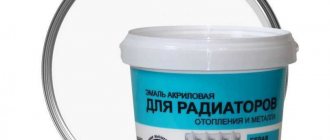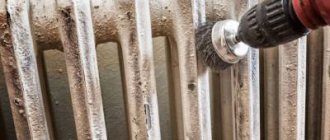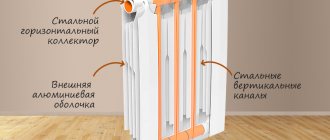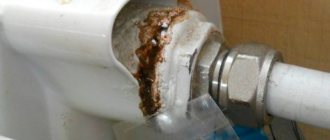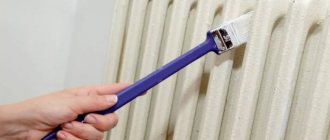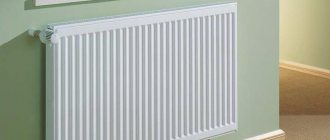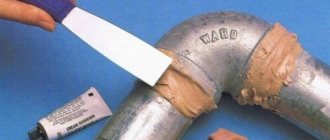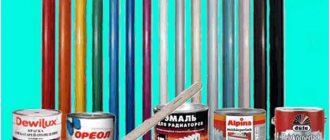In apartment buildings, one of the most common problems with the heating system is leakage of heating batteries; this happens less often in autonomous systems of private houses. Basically, depressurization occurs during hydraulic tests. Weak and worn joints cannot withstand strong pressure and begin to leak water through joints or microcracks in radiator housings.
This can happen in the most harmless situation; residents should always be prepared for such cases. People who have not encountered a similar problem immediately panic, not knowing what actions to take. First, you should place a suitable container under the flowing stream so that water does not spill onto the floor.
Why is the heating battery leaking?
Before figuring out how to fix a radiator leak between sections or in another place, you need to understand the causes of the problems that arise:
- Cast iron radiators are heavy and are mounted on durable hooks. With minimal error, radiators sag under their own weight, and a misalignment of several millimeters causes the formation of air pockets. Corrosion begins in these places - the cast iron becomes thinner and over time a fistula forms. A minor leak appears, which it is advisable to quickly fix.
- In houses with a centralized heating system, water hammer often occurs, which sometimes causes radiators to leak at the joints (especially for bimetallic radiators).
- Cast iron radiators are rough inside, so all kinds of debris and foreign inclusions linger on the surface: pieces of metal, rusty sediment, etc. Gradually, the channels begin to clog, and deterioration in coolant circulation leads to the risk of a breakthrough or leak. This is another reason why batteries, both cast iron and steel, leak.
- Gaskets and nipple threads are the weak points of heating radiators, so leaks can form in these places.
Practice shows that leaks in aluminum, steel and other radiators do not appear suddenly. First, characteristic signs appear: the air temperature in the room decreases, plaque forms on the radiator, and corrosion spots form on the surface.
Do not remain idle when you notice these signs, but decide what to do - the battery is already leaking. If you ignore the situation, an accident may occur. You may also soon find a puddle of water under the radiator, and the humidity level in the room will increase noticeably. You can repair the leak in the heating radiator yourself or contact a professional. An experienced plumber from our company will quickly fix leaks in any radiator: aluminum, steel, bimetallic, cast iron.
Many people are concerned about the question: if the battery is leaking, who should they call? If you live in an apartment with central heating, contact the management company or us. In other cases, you can do without a management organization - it will not help you.
How to fix a leak in a heating radiator
What to do when the radiator begins to leak at the joints, between adjacent sections, or when the faucet leaks? Many people, when they discover a leak, are confused and do not understand what to do. First of all, you need to turn off the coolant supply and place something under the place where the water is dripping or flowing. In a private house there will be no problem with this, but apartment residents may have to go to the basement to turn off the supply valves on the entire riser (if the apartment does not have valves on the radiators).
We must warn you right away: if you don’t have a set of tools and spare parts, don’t even think about how to fix a leak in an apartment or house on your own. Otherwise, you can only make things worse. It’s better to call a specialist by calling our company. If you decide to do it yourself, try to follow the instructions for each specific situation.
FAQ
Homeowners have the same questions about how to solve such problems.
The following are often of interest:
- where to go if the battery leaks;
- what to do if it is not possible to turn off the water;
- who is to blame if the neighbors are flooded?
Where to go if the heating battery is leaking?
It makes sense for owners of apartments in multi-storey buildings to call a plumber by contacting the housing and communal services service, HOA or management company. Emergency telephone numbers should be posted in entrances. There is an option to call an employee of a private company that provides such services. In a private home you will have to deal with the problem yourself.
How to eliminate a leaking heating battery without shutting off the water?
If the cause of the leak is a crack in the pipe, it can be wrapped in rubber and tightened from above with any clamp or wire. If it is a small sink, then you need to take a metal screw with a rubber washer and screw it in with a screwdriver. These measures are only effective at low pressure in the circuit. After the manipulation, you need to turn on the pump and make sure that the repaired area can withstand the water pressure in the system.
When radiators leak in an inaccessible place and the leak is small, you should add mustard to the expansion tank. Place a container under the dripping unit and increase the temperature of the water in the system. Mustard powder, like a liquid sealant, reaches the leak and closes it. There are ready-made liquid sealants on sale just for such cases. Add them to the system, and all minor leaks will stop bothering you.
Who is to blame if a heating pipe bursts and floods the neighbors?
The owner of the apartment panics when hot water breaks out and rushes out in all directions. By the time you reach the tap, the entire floor will flood. And the floor of the room serves as a ceiling for the neighbors below. You can localize a leak by throwing any thick rag over the break site. The water will flow down it, where you place the basin. This will give time to turn off the water and turn off the pump, if there is one.
When your apartment has centralized heating, the algorithm of actions is different.
A breakdown in the heating system can happen at any time of the year. The management company must conduct technical tests of pipes before the heating season. To do this, they are tested by applying high pressure. Residents should be warned about this. If a breakthrough occurred as a result of such a procedure, then the actions are as follows:
- If you are at home at the time of the breakthrough, then turn off the water.
- Call the management company by phone and report the incident.
- Capture on photo or video:
- location of damage (breakthrough);
- consequences of flooding: damaged property in your apartment;
- damaged property and belongings of neighbors.
- Achieve the drawing up of an act.
Sometimes citizens think that it is better to install air conditioners and turn them on for heating than to compensate their neighbors for damage. Air conditioners are not designed to operate in temperatures below -4°C. The condensate in the drain pipe freezes, the external unit suffers, and the device may fail. It is best, if possible, to install individual heating. In this case, it is necessary to replace metal pipes with plastic ones and install aluminum radiators.
Depressurization of the radiator wall or fin
This kind of damage brings big trouble. It is extremely difficult to fix a problem when the battery is leaking, but for a short time you can find a way out of the situation. The method is quite simple.
The small hole on the battery needs to be enlarged. Before doing this, you need to turn off the water and reduce the pressure. Using a drill, make a hole larger than it was. A wooden peg is inserted into the drilled hole. When exposed to water, it swells and stops water leakage.
You can also use a self-tapping screw with a rubber washer instead of a peg.
Of course, leaving the battery in this state for a long time is dangerous; the section must be urgently replaced with a new one.
Pipe connection is leaking
Leaks at pipe joints can be eliminated using the same homemade or factory-made clamps. If there is a difference in diameter, you can first wind the rubber band and then make or put on a clamp.
If the connection is threaded and drips from under the winding, you can pour alcohol onto the tow and then spread it with BF glue. It is alcohol soluble. Once on the alcohol-contained tow, it liquefies and can flow into the joint. Then, when the alcohol evaporates, the glue dries, and the “drops” stop. But this method only works if you have “drops” and not a “fountain”. And one more thing: such a processed connection is then very difficult to disassemble.
If it is possible to stop the system or disconnect the radiator (if there is a leak at the junction with it), it is better to repack the threaded connection. To do this, carefully and slowly unscrew the nut (lock nut). It needs to be turned away and then wrapped. Don’t make significant efforts - there is a high chance of breaking it, and then you will definitely have to stop the system and redo everything. After tightening the nut, remove all the tow or fum tape, remove any remaining sealant, and in general, thoroughly clean the threads. Wipe it until clean, you can treat it with a degreaser (acetone or pure gasoline).
If it leaks under the locknut, it can be repacked
Please note that there is no excess tow - just a little, and paste on top. Take the winding and paste (sealant), wind the flax and coat everything with the paste. Now you can twist
First with your hand, then with a key. But here you also need to work carefully: it’s very easy to break the thread. Therefore, hold the key not by the edge, but in the middle - it’s easier to calculate the effort. Don’t overdo it with the amount of tow either. If cast iron, in principle, does not matter how much winding you wind, then aluminum and bimetallic, as well as steel, can crack from a large amount. A microcrack first appears in the collector, into which water leaks. The metal corrodes, the paint swells, a section (or the entire radiator) is damaged
Now you can twist it. First with your hand, then with a key. But here you also need to work carefully: it’s very easy to break the thread. Therefore, hold the key not by the edge, but in the middle - it’s easier to calculate the effort. Don’t overdo it with the amount of tow either. If cast iron, in principle, does not matter how much winding you wind, then aluminum and bimetallic, as well as steel, can crack from a large amount. A microcrack first appears in the collector, into which water leaks. The metal corrodes, the paint swells, a section (or the entire radiator) is damaged
Take the winding and paste (sealant), wind the flax and coat everything with the paste. Now you can twist it. First with your hand, then with a key. But here you also need to work carefully: it’s very easy to break the thread. Therefore, hold the key not by the edge, but in the middle - it’s easier to calculate the effort. Don’t overdo it with the amount of tow either. If cast iron, in principle, does not matter how much winding you wind, then aluminum and bimetallic, as well as steel, can crack from a large amount. A microcrack first appears in the collector, into which water leaks. The metal corrodes, the paint swells, a section (or the entire radiator) is damaged.
But this is all in cases where the threaded connection is leaking. If a fitting under a press (metal-plastic pipes) has leaked, you can try to simply tighten it. In the case of copper pipes, only soldering will work. If there is a leak at the junction of polypropylene pipes, there is also only one option - cut out the damaged piece and weld a new one.
It doesn't matter what you use. The result is important
Sealing
Next you need to act according to the circumstances. If the “hole” is located in the upper part of the battery, and when the heating system is stopped, water stops flowing from the damaged area, then repairs can begin. If a leak has formed in the lower part of the radiator, then before the “treatment” of the equipment it is necessary to drain the coolant either from the entire system or from a specific element (usually this is possible with a bypass that allows liquid to bypass the equipment being repaired).
Naturally, before gluing, you need to wipe and thoroughly dry the area you will be working with. In addition, you need to clean the surface of peeling paint and similar debris. Otherwise, the result will not be of satisfactory quality.
Epoxy resin can be used in its original form, that is, directly after purchase in a store. But you can slightly improve the composition, giving it greater final strength. To do this, an additive is added in the form of bronze or aluminum powder. It is very easy to obtain the powder by using a rasp to process any part of the corresponding metal - naturally, having previously placed a sheet of paper under the work area, on which the powder will collect. Add the resulting material to the epoxy and mix properly.
If for some reason you cannot use epoxy glue, then instead you can use zinc white, diluted to a thick paste. In any case, the work is carried out in the same way.
- Cut the fabric into strips. The width of each of them should be twice the diameter of the area being repaired. Calculate the length so that you can wrap the element 6 or 8 times.
- Coat the area to be repaired with epoxy resin or zinc white. Naturally, this must be done not only at the leak itself, but also at a certain distance on both sides of it.
- Wrap a fabric strip tightly over the area treated with adhesive. Then coat it and repeat the procedure with the next strip.
- After all the fabric strips have been wound (the topmost one, of course, no longer needs to be coated with adhesive), secure the whole thing at both ends with clamps or strong wire.
you can find
Types of leaks
Each connection of parts represents a potential threat of possible depressurization.
Please note: a leak is the release of coolant from the heating system due to damage in one of the elements.
Depending on the type of connecting elements used, there are several types of leaks that are typical for heating batteries:
- leakage resulting from a crack in the battery section;
- damage to the tightness of the main pipes that connect the main riser to the batteries;
- leaks in the intersection connections of the heating radiator;
- depressurization of the connection between the radiator and pipes.
Each type of leak needs to be repaired using certain repair methods.
Fixing a leak between two sections
The technician needs to perform additional sealing of the joints. Those areas that are located between the two sections are distinguished by their unique rectilinear shape and small area. Thanks to this, you can find a defect much faster and eliminate it efficiently. Experts recommend using a simple algorithm of actions:
- You should try to strengthen the guide screw using a classic car clamp.
- If desired, the master can make the fastening element himself. To work, you will need several plates made of durable steel (aluminum blanks). The hinges can be tightened using a classic bolt connection.
- Before using clamps, you should isolate problem areas using a rubber gasket. You can also use a piece of fabric that is impregnated with epoxy glue.
Attention! The winding between the batteries must be done as carefully as possible so as not to overtighten the connection. Particular care is also taken when fastening the clamps.
Between battery sections
If a leak appears between the sections, this means the rubber or paronite gasket has become inelastic and/or the coolant has corroded it. There is another possible reason - corrosion has “eaten” the nipple. In any case, for major repairs it is necessary to disassemble the heating device into sections and replace the damaged part.
If the heating does not work or the radiator can be turned off without stopping the system, it is removed, disassembled, old gaskets are removed, new ones are installed and reassembled. Read how to assemble/disassemble the battery here.
If not, you can temporarily seal or seal the leak. It is very difficult to perform this trick with aluminum or bimetallic radiators - the distance between the sections is very small. But with cast iron type MS-140 it’s possible to do this.
First you need to clean the leak site
First you need to clean the place where the coolant is leaking: remove everything to the metal. Where there is access, remove with a spatula or a brush with metal bristles. Where there is no access, we take a metal cable and peel it off with its help. We pass it around the collector in the place where processing is required, and pull it by one end or the other. After a while, everything that can fly away flies away.
On the cleaned surface we will apply the same composition as when insulating pipes: epoxy resin and metal powder or “cold welding”. Only the strips of fabric needed are narrower and longer. Wipe it dry and clean, apply the compound, wrap it in cloth, apply more glue, another turn. So 4-5 turns. Do not smear the top one. For reliability, you can tighten it at the top with a clamp.
If you have ready-made iron putty, you can apply it (or make it). Then 3-4 turns of fabric coated with the composition will be enough. The simplest recipe that is suitable for eliminating a leak in a cast iron battery: add drying oil to red lead and grind to make a paste. And apply it between sections. If you have white lead, mix it with red lead and add drying oil. The consistency is the same: mush.
In any case, such radiator repair is only a temporary measure. After the end of the heating season, repacking is necessary.
The battery is leaking. What to do with your own hands?
You must act, first of all, not with your own hands, but with your own feet. Go to the housing office and give it to a welder so he can repair your leak.
Cold welding for Mastix radiators
If this option does not suit you, then you need to go to a construction supply store and buy Mastix cold welding for radiators and pipes. Essentially, it is an epoxy-based glue filled with metal powder, the main beauty of which is that it also glues wet surfaces.
How to use Mastix is described in the attached instructions, as well as in the article on our website “Welding heating radiators: hot and cold.”
If you are interested in how to install a radiator correctly, detailed instructions for installing a radiator are presented in our next article.
The main types of breakdowns of heating batteries
Metal corrosion is the most common cause of leaks
In order to competently and reliably eliminate a leak in a pipe or radiator, you need to know and have a good understanding of the nature of the occurrence of such a phenomenon.
The formation of cracks and holes occurs for the following reasons:
- metal corrosion that occurs when black iron comes into contact with oxygen present in air and water;
- use of low-quality material when assembling the structure;
- water hammer, the consequence of which is the appearance of cracks;
- wear of gaskets installed at joints and in places of threaded connections;
- mechanical damage associated with a strong blow from a hard object during repair or movement of household appliances;
- violation of assembly and welding technology during installation.
In places of threaded connections, leaks are caused by leaky rubber gaskets
All these prerequisites lead to breakdowns of the following nature:
- Gaps in the radiator. Such malfunctions are the most unpleasant, as they appear in difficult, sometimes inaccessible places. Sometimes several ribs or the entire product are covered with water. Most often, the heating battery leaks at the joints of the sections. This occurs due to drying out of the gasket or increased pressure in the pipeline. Less often, holes form in the housing. The reason for this lies in a manufacturing defect, which is impossible to identify at the installation stage, since the defect manifests itself over time.
- Through cracks in pipes. They are the result of poor quality welding or manufacturing defects. Most often they occur at the seams of piping pipes, at their junctions with each other and with the riser. Often the problem arises due to electrolytic corrosion when property owners short circuit the heating circuit to zero or ground from household appliances.
- Freezing or overheating of the pipeline. A common problem for country houses and dachas, sometimes occurring in the urban sector. Expanding when freezing, water tears apart the metal, leaving cracks of varying widths and lengths. They may not be immediately noticeable, but when the water thaws, the defect will immediately appear. When iron overheats, thermal expansion occurs. If communications have nowhere to move, they collapse, burst or crack in weak spots.
- Cracks in the joints of batteries and pipes. Leakage occurs due to a leak in the connection. The most common cause is metal corrosion as a result of the welding joint. Sometimes a hole is formed due to the inexperience or negligence of the craftsman, who left a thin layer of metal on the seams. The problem of leakage may be due to the wrong choice of installation location for load-bearing anchors, when mechanical stresses arise due to misalignment. Often a pipe leaks after people have stood on it or suspended heavy objects.
General recommendations
There are many ways to fix a radiator leak available to the owner, and he can choose the most suitable option based on the equipment available. However, the above recommendations make it possible to urgently solve problems in the winter season, when it is not possible to turn off the heating system for a long time and carry out major repairs of heating devices.
It is quite natural that homeowners have a question: the heating battery is leaking, what to do in the summer? Having survived the winter with a hastily patched radiator, in the summer you should remove the battery from its mounts, inspect for damage and carry out a number of measures:
- remove old patches;
- clean leaks with a wire brush;
- treat cracks and holes with a grinder and a cleaning wheel;
- eliminate the defect by soldering or welding.
Next, you should paint the battery (you can read about paint for radiators here) and install it in place. In this case, it is important to follow the installation rules - use tow, FUM tape, high-quality shut-off valves and pay special attention to the joints.
Having installed the battery in the circuit, it is worth filling the system with water and checking the tightness of the heating device. It is important to carry out this step while the boiler is running, since the circulation of coolant under pressure can reveal leaks and weak points in connections. If no leak is detected during intensive use of the heating system during the day, then the problem can be considered solved.
Temporary solution
So, if water runs in a thin stream from any place in your radiator, and you do not have the opportunity to stop the flow of coolant, then you can try to block the damaged area in such a way as to prevent further troubles. To do this, you will need something rubber: for example, an old rubber boot, an inner tube from a bicycle or car wheel, a household or medical glove - in general, anything as long as it is made of rubber.
The algorithm of actions is simple.
- Cut the rubber product into strips. The longer they are, the better. The width of each strip should be such that the leak can be completely covered.
- Now you need to wrap the damaged area with the resulting strips. Start the process near the place where the water is flowing, gradually moving towards it. The turns should overlap each other slightly. It is necessary to wind the rubber as tightly as possible - the tighter the fit of the strips, the more reliable the effect will be.
- After the winding is done, it needs to be fixed. To do this, make a tie using a fabric tourniquet - it must be placed over the leaking area. Instead of fabric, you can use strong wire, but it must be wound in the same way as rubber, in turns across the entire width of the original winding. A car clamp is also suitable - this is generally quite a useful thing that can be useful on the farm many times, so it is recommended to purchase more of them for the future. Another option for securing the patch is a strip of tin. It can be tightened over the rubber using bolts.
Of course, such a solution is only temporary. Ideally, after eliminating the leak in this way, it is still advisable to call the emergency service so as not to risk it. But in many cases, such a rubber patch helps you survive until the end of the heating season, and then you can safely do more general repairs or replace the battery.
You can make your life even easier if you purchase special plumbing clamps to eliminate such troubles. They are designed specifically for pipe repair. Such a clamp is a metal product with rubber attached to the inner wall. That is, in essence, this is the same patch described above, but its application is much more convenient - fixing the leak will take about a minute.
If this solution does not work, and the coolant still continues to leak from under the patch, then you still need to either call an emergency team, or, if possible, stop the heating system yourself and begin serious repairs. There are several ways to eliminate a leak. The simplest of them is gluing.
This is interesting: How to choose bathroom furniture
Prevention and care of radiators in summer
After the completion of the heating season, the pipeline must be tested (pressured) with increased hydraulic pressure. This is done in order to identify weak points and repair areas where ruptures or coolant leaks have occurred. The house main is subject to periodic internal flushing by utility services. Water is supplied to the system along with compressed air under pressure. A temporary break is made on the return line (unwinding of one of the connections) to drain dirty water through a hose or hose.
Dust and dirt accumulate on the outer surface of the batteries and on their ribs, which must be washed off in the summer with a cloth moistened with soapy water. Once warm, the cleaned surfaces can be coated with fresh paint. This will make them dry faster. Make the paint layer thin, otherwise it will crack later.
To avoid damage, do not use the equipment as supports or tie clotheslines to the risers. Read about warm floors on a wooden floor on our website.
Actions in case of leakage
When urgent measures do not give a positive result, you need to drain the water from the system and make high-quality repairs to the damaged area.
For this:
- turn off the tap on the riser, warning your neighbors if it is a common valve;
- drain the water from the system.
Knot near the riser
One of the common damages is at the junction of the riser and the pipe. Leakage in this area may occur due to poor sealing of the joint. It is possible that when attaching the pipe, they did not put enough windings on the thread or did not tighten the lock nut.
The connection must be disassembled and re-twisted. Use tape or sealing thread to wind the FUM. It is advisable to replace the locknut. If the weld seam is leaking, then the water from the riser must be drained and the seam made again. To do this, you need to hire a welder.
Radiator sections
Radiator sections are pulled together. There are rubber gaskets at their junction points. Over time, the tie may loosen or the gaskets may become unusable. Water makes its way at the junctions of the sections. First, use adjustable wrenches to tighten the connection without removing the radiator.
If this does not help, then remove the faulty battery. Shut off the water supply, drain the water from the system and unscrew the radiator. Disassemble into elements, install new gaskets. Clean the sections from slag. Reassemble and install.
Battery input
Warm water flowed where the pipe enters the battery. This is a threaded connection consisting of a drive, a coupling and a lock nut. These elements are made separately and sometimes not from high-quality metal. In addition, if the battery is cast iron and poorly secured to the brackets, it creates pressure that deforms the joint over time.
This unit definitely needs to be replaced. It happens that it is impossible to unscrew rusted parts, then they are heated with a gas burner
This operation is carried out with extreme caution, having prepared fire extinguishing agents and fencing the work area with protective screens made of non-combustible materials.
Battery edge
If a crack forms in an accessible area of the battery fin, it can be temporarily neutralized. There are 2 types of welding of heating batteries: hot and cold.
If the battery registers are metal, then hot welding can help fix the leak. If they are aluminum or cast iron, then you can forget about it. In this case, cold welding will help. This requires a high-temperature, water-resistant plastic mass that reacts chemically with such metals.
The area to be welded must be thoroughly cleaned, degreased and dried. Knead the substance until it is homogeneous, apply a small layer and let it harden. Welding products such as ABRO STEEL or POXIPOL do an excellent job. The range of such adhesives is wide. You can select welding for the material from which the radiator is made.
Faucet or joint
When the source of the leak is a faucet, it must be replaced. If the tap has not been used for a long time, it becomes clogged with deposits and does not fulfill its task. However, if its rotating part is moved out of place, it can also leak. When choosing a new shut-off device, give preference to ball valves made of non-ferrous metal.
Leaks at joints can be eliminated by wrapping the damaged area with a bandage soaked in saline solution. After drying, cover the top with a bandage soaked in a mixture of plaster and cement.
Modern industry offers consumers plate glue for this purpose. You should wrap the finished strip around the leak area. When exposed to air, the polymer hardens and eliminates the problem. When using silicone sealants to eliminate leaks at faucet joints or threaded connections, choose neutral compounds. Acid-based sealant may promote subsequent metal corrosion.
Fistula in the rib of the battery
This type of leak can be considered one of the most unpleasant, since it requires significant effort to eliminate. But temporarily, you can use a simple method to eliminate such a leak. If the hole where the leak came from is small, then you will need to enlarge it a little. For these purposes, the water is completely shut off and the pressure in the batteries is reduced. After this, using a small drill, the hole is slightly drilled out. This is done in order to insert a peg into the hole from which water is leaking. It can be cut from a small wooden block. It will swell with water and plug the leak well.
Who is to blame and where to call
If the heating radiator is leaking, then, firstly, you need to take a closer look at where it is leaking from and substitute a basin.
You need to place a container under the leak to collect the coolant.
The second question that a citizen has after he is convinced that his battery is leaking: “Who should I call?”
You need to call the housing office or another service company. Most likely, you will be promised to immediately turn off the defective radiator and will be put on a waiting list for repairs or battery replacement. The fact is that, according to the current legislation, and more specifically, the Decree of the State Construction Committee of the Russian Federation No. 170 “On approval of the rules and norms for the technical operation of the housing stock” dated September 27, 2003 and the Government of the Russian Federation Decree No. 491 dated August 13, 2007. , the house heating system, including radiators, is the common property of the house.
Plumber servicing a heating radiator
Therefore, even if the battery leaks in a privatized apartment, its repair or replacement must be carried out at the expense of the monthly contributions that you pay for the maintenance of your home. Don’t accept any excuses like: “Your apartment, your battery is leaking, who should replace it if not you?” For failure to comply with the above resolutions, housing and communal services managers can be brought to administrative or even criminal liability.
But this is in theory. But in practice, fees are collected, but the plumber who comes from the housing office will turn off not just one radiator from the heat supply (if it is equipped with a tap, then you can turn it off yourself), but your entire apartment. And the queue for battery replacement or repair can last for months. During the heating season, when batteries leak, this option is unlikely to suit you.
Is scheduled maintenance required?
During the off-season period, when the heating is not turned on, it is necessary to carry out maintenance of the heating systems. Periodically drain the water and flush the circuit and boiler with reagents containing corrosion inhibitors. Filled into the system for 40 minutes or more, a special liquid will rid the circuit of toxins, salts, corrosion and other deposits. After cleaning, it is necessary to rinse the system with running water and refill. If minor repairs and leaks were repaired during the heating season, it’s time to replace the damaged elements.
Elimination of fistula
For any breakdown there are a number of reasons accompanying it. A fistula on heating system pipes or on a radiator is no exception. If a small brown spot appears on the elements of the heating network, you should not think that it is paint coming off. In fact, this is the beginning of an often irreversible process, but knowing how to repair a fistula in a cast iron battery, you can stop the destruction and extend its service life. Causes of corrosion:
- Taking into account the frequent increases in the cost of utilities, some craftsmen are cunning and, in order to save energy, connect a neutral cable to the heating circuit. The currents that begin their “journey” through the pipes through the coolant are what cause the formation of corrosion. You can identify a dishonest neighbor if there are several fistulas and they appear with a certain regularity. Calling the appropriate service to identify the intruder and repairing cast iron batteries yourself will help save the situation.
- Too much acidity of water can harm even corrosion-tolerant cast iron.
- The batteries have expired or deposits on the battery walls have damaged the metal. In this case, even a small fistula or crack under the influence of water pressure can cause the battery to burst and a stream of hot water to flow from it.
Any of the options requires urgent intervention. If the cast iron battery leaks only slightly, then you can do without disconnecting the circuit and dismantling it. A clamp can save the situation. If the water only drips, then a one-sided clamp will do, but if it runs in a thin string, then it is better not to risk it and use a double-sided clamp.
In the event that the coolant ruptures the place where the fistula was located, the question immediately arises whether it is possible to weld a cast-iron battery. As a rule, cold welding becomes an emergency solution, but even if it has restored the tightness, it is necessary to call specialists from the heating network to check the condition of the heating system.
Correct check of radiators before the heating season
Battery checks should be carried out in the summer. Immediately after the heating season, it is recommended to perform pressure testing. To do this, increase the hydraulic pressure in order to identify weak points. If leaks are detected, they are repaired.
Checking radiators should consist of several stages:
- Thorough external cleaning of radiators . Dirty batteries weaken the system and cause unpleasant odors. In addition, uncleaned batteries can become sources of harmful microorganisms that can bring illness into the home. When servicing equipment, detergents should be used.
- Cleaning the batteries inside . To do this, you can use dust brushes with a long handle. You can buy periscopic devices on the market to get to the most inconvenient corners. It is advisable to carry out internal cleaning at least every 5-7 years.
- Adding water . When the radiators are already clean, you can begin ventilating the heating equipment. During downtime, a large number of air pockets could appear that block water circulation. The air should be completely expelled from the system.
Poll: Do you carry out annual inspection and pressure testing of your heating system?
Battery leaks in heating systems occur quite often. You always need to be prepared for this. Scheduled maintenance of the heating system guarantees uninterrupted operation for a long time. But it’s still better to always play it safe and keep the necessary tools and supplies at home in case of breakthroughs. The equipment must be monitored at all times to avoid unpleasant consequences.
The most common problems and their symptoms
Although cast iron perfectly tolerates the imperfections of the central heating coolant, and the radiators made from it have wide enough channels so that debris does not accumulate in them, problems can arise even with them. And this despite the fact that there is no wear to this metal. The following factors may be to blame for a cast iron battery bursting or a fistula appearing in its walls:
- Everyone knows the heavy weight of radiators made of this metal. If during installation of the structure, insufficiently strong brackets were used, or there were not enough of them, over time it may sag under its own weight and tilt. Even a slight deviation of just a couple of millimeters will reduce the efficiency of the device, and if the distortion is not corrected, then after a few years corrosion will appear in the place where the coolant is missing. At first it will look like a small brown spot, which will grow with each heating season until a fistula forms in its place.
- The reputation of “long-living” is characteristic of both old and new models of cast iron radiators, but provided that they are installed in the contour of an apartment building no higher than six floors. If the heating network is reliable and does not suffer from strong water hammer, then they can be installed in nine-story buildings. Otherwise, under strong water pressure, the cast iron battery may leak at the joints of the sections. In the event that a cast iron battery leaks during the heating season, you need to know in advance how to repair it. Today there are a lot of sealants that will help the device “hold out” until warm days.
- The internal structure of domestic batteries is such that the cast iron from which they are made has roughness that is completely absent in imported analogues. That is why a lot of debris is deposited on the walls over time, which fills the water in the heating network. Suspensions, particles of rust and metals, all settle and make the wide channel so narrow that it is no longer able to easily pass coolant under high pressure. In this case, the structure may burst anywhere, and then you will have to urgently decide how to eliminate the leak in the cast iron battery.
- Gaskets and nipple threads are the weak “link” of heating devices. If cast iron does not have a statute of limitations, then the same cannot be said about the parts that make up the battery. In order not to lead the situation to the point where repair of the cast iron battery is required, the connections must be checked after each heating season and the gaskets on them must be periodically changed.
As practice shows, most often it becomes known that something is wrong with the heating system when repair of cast iron radiators is already required. To find out about a problem in advance, you need to listen for “help signals” that indicate the presence of defects.
The use of rubber gaskets and conventional clamps
Before repairing bimetallic heating radiators, you should prepare some materials and equipment:
- Pliers.
- Aluminum clamps.
- Wire.
- Classic gasket made of durable rubber.
The repair technology includes a certain list of important stages. A gasket is placed in place of the leak and everything is secured with a clamp. If you don’t have the right tools at home, then a simple wire and a bicycle tube will do just fine. From this material you can carefully cut a piece of rubber of the appropriate size. You can secure the homemade gasket with strong wire. To achieve a good tie, you need to use pliers.
Heating system adjustment
After filling the system, you need to go through all the radiators and bleed air through the Mayevsky taps: open the Mayevsky tap, first the air comes out, then the tap “spits” air with water... when only water flows, it means the radiator is filled with water, close the Mayevsky tap. And so on for all radiators.
Most likely, the pressure will drop after manipulating the radiators, so we re-charge the system to operating pressure. If there is a second floor, we bleed air from its radiators in the same way. And - we feed the system to operating pressure.
We bleed the air from the circulation pump. The pump has a screw; you need to loosen it with a wide slotted screwdriver. First, air will come out like from radiators, and then water will come out in a thin stream. After this, tighten the screw. Check the pressure and add coolant if necessary.
Let's start the pump.
Important! Before going any further, listen to see if the pump is working. It happens that it does not work because its rotor is soured
Turn off the pump and fix it by: 1) unscrewing the screw in the center of the pump motor; 2) inside, at the end of the rotor, there is a slot, insert a screwdriver into it and turn the rotor; 3) screw the screw into place. Let's turn on the pump again, it simply must now work.
For 10-15 minutes. Moreover, after 1...2 minutes of operation, we unscrew the screw on the pump again, if water flows, everything is in order. When you turn on the pump, you will hear air coming out of the air vents again, this is also normal. And the pressure will drop, and we will feed the system to the 1.5 atm we need.
While the pump is running, we go through all the Mayevsky taps and check the presence/absence of air in the radiators. And again we feed the system to the required pressure.
Now we believe (for now we only believe) that the system is completely filled with coolant (but we are not too delusional, air can leave the system for up to 3 weeks or even up to a month, especially if there is a water-heated floor; air will leave the warm floors itself through air vents on the manifolds).
Fighting cracks of different diameters
Elimination of such defects has its own characteristics. The most suitable option is to use traditional welding. But this option is quite labor-intensive, and also implies the presence of appropriate equipment and minimal skills. As an excellent alternative, you can use special glue. First, the technician needs to prepare the problem area of the battery. The process itself is based on cleaning the surface and degreasing it.
The prepared cold weld fragment is pressed against the crack formed with a certain force. This material stands out for its quality and reliability, since it polymerizes within a few minutes. It takes 35-45 minutes for the formed seam to harden. The very next day, the restored battery can be put into operation, but after the end of the heating season, such a device will need to be replaced, since such welding falls into the category of temporary repair work.
Rewinding the cork for better sealing
The pipe is leaking - what to do at the first stage
In the event of a fistula appearing on the central heating riser, from where water is gushing out, we offer the optimal plan of action:
- Organize the coolant drain into a bucket or basin by quickly wrapping the pipe with any rag. This way you will preserve the flooring, personal belongings and furniture, and prevent flooding. Proceed with caution - in winter the temperature of the network water reaches 90 °C.
To prevent your neighbors below from forming such a bubble, collect water in a bucket - Spend 2-3 minutes calling the dispatcher of the heating supply organization. Report the accident, call the plumbers.
- While the repairmen are getting there, try to close the riser yourself. Too hot a coolant will still not allow you to close the fistula under pressure.
- Taps should be found in the basement heating point located under the entrance. Observe where the riser penetrates the ceiling and close the nearest valve. As a last resort, turn off the main house tap during repairs.
An example of the location of shut-off valves in a heating point
Advice. If, before the plumbers arrived, it was not possible to tie a rag around the riser and stop the flow of coolant, throw an old blanket or a thick coat over the pipe that absorbs water well.
In the current reality, craftsmen often have to wait 2-3 days (reasons: holidays, weekends, accidents at other facilities). It is impossible to leave residents without heat for a long time, so in case of delay, make an improvised clamp from scrap materials:
- Find a rubber glove, a bicycle tube, or a ready-made medical tourniquet. The second component of success is soft steel wire with a diameter of 2-4 mm.
- From a glove (bike inner tube), cut a strip 4-5 cm wide, as shown in the photo.
- Applying the end of the strip to the pipe 1 cm below the fistula, wind it with tension. The goal is to tightly seal the hole with several layers of rubber.
- Hold the “bandage” with your hand and secure it with wire. It is better to wind the latter tightly, turn to turn, helping with pliers. Now the common valve in the basement can be opened.
Note. On a water supply system, the described procedure is performed under pressure, if it was not possible to cut off the riser from the main line. It is not necessary to wind many turns of wire; the main thing is to temporarily stop the leak.
Also use the procedure described above when a cast-iron central heating radiator is leaking heavily and there are no shut-off valves. Typically, radiators leak at the joints between sections, and a temporary clamp should be applied there.
When a leak forms from under the nut, the connection must be repacked
If a trickle of water is observed at the place of the threaded connection of iron pipes, you need to unscrew the fixing nut from the coupling with a gas wrench. Wrap the exposed thread with a braid of fresh flax (clockwise) and tighten the nut again. The plumber will show the considered sealing options in the video:
In a private home, eliminating a leak is greatly simplified - just shut off the required valve or quickly empty a section of the heating network. It is not necessary to wind the rubber; it is better to repair the hole using a more reliable method. When the leak in the apartment is temporarily fixed, you don’t have to wait for locksmiths - choose the right time and finally seal the hole using any of the methods presented below.
Damage to the heat exchanger and pipes
If the heat exchanger of a gas boiler is leaking, the wall may have burned out, a crack or a fistula has formed. Based on the material used, heat exchangers are divided into copper, steel, and cast iron.
Cracks in metal are formed under the influence of thermal stress and hydraulic pressure. Corrosive processes lead to the formation of fistulas. Repairs are carried out by soldering.
Main stages of the process:
- dismantling the heat exchanger;
- cleaning and degreasing the area around the leak;
- soldering using flux and solder;
- trial;
- installation.
If there is a leak in an easily accessible place, complete dismantling of the heat exchanger for repair is not necessary. It is enough to remove the casing, turn off the gas and water, disconnect the electrical wires, and drain the remaining water.
For soldering, select a solder that corresponds to the material of manufacture, for example, copper-phosphorus solder containing silver is suitable for copper heat exchangers; the temperature regime at the soldering site must be observed
The soldering area is cleaned and degreased with a solvent. Soldering is performed using a soldering iron or gas torch. The heat exchanger is installed in place and communications are connected to it.
Tests are carried out by crimping. The circuit is filled with water, the pressure is increased to the test value and monitored using two pressure gauges for at least 5 minutes. If no pressure drop is detected and no leaks are noticed during a visual inspection, the repair can be considered complete.
In case of severe damage, repairing the heat exchanger is impractical. It is simply replaced with a new one. It is also impossible to solder many Chinese-made heat exchangers, since they are made of thin-sheet alloys that cannot withstand soldering.
Use of special sealants
Unlike mechanical means, the use of sealing compounds does not provide a 100% guarantee of eliminating leaks. On the other hand, it is impossible to use clamps and tape on the flat surface of the radiator when the fistula is located directly on the front panel. There are 3 options left: try a chemical, weld the hole, or replace the battery.
Undoubtedly, sealant for pipes and radiators is the most convenient tool for the average user. Before throwing the heating device into a landfill, you can try to seal it. What sealants are usually used in such situations:
- two-component plastic composition called “cold welding”;
- liquid agents added to the coolant;
- adhesive heat-resistant plastic that hardens after ultraviolet radiation.
Reference. High-quality cold welding from Loctite costs about 27 USD. e., 1 liter of liquid sealant “Aquastop” – 72 USD. e., light-curing plastic Bondic – 32 cu. e. per set.
Two-component waterproof glue will definitely help if you strictly follow the technology - dry, clean and degrease the defective area before applying a patch. See the video below for cold welding tests on water pipes.
Liquid sealants are offered for different coolants (water, antifreeze) and types of heating systems. After adding the product, chemical compounds fill the fistulas from the inside within 2 days. Of course, large defects and through holes cannot be repaired; you must first use a mechanical method. For example, hammer a wooden chop into the hole.
Note. Aquastop liquid is mixed with the coolant in a ratio of 1: 100. That is, it will take no more than 0.5 liters of product to seal the closed system of a one-story house.
Bondic plastic gel is sold complete with an irradiator and is applied to the damage in small portions. Each subsequent drop is illuminated by ultraviolet light and instantly hardens. An indispensable condition is a dry, grease-free surface; the type of pipe material does not matter.
Plastic becomes solid after irradiation with ultraviolet light, before which the material remains liquid indefinitely.
Sequence of work
Depending on how serious the breakdown is, the steps to fix it depend. So, if the leak is small, then you can do without disconnecting the battery from the circuit, and for repairs you will need:
- Place a container under the breakdown site in case of a breakthrough or an oilcloth with rags to collect water.
- The area of the rupture or crack must be cleaned down to the base using a cable or sandpaper. It is necessary not only to remove a layer of paint, but to expose the metal itself.
- Degrease the prepared area with some solvent.
- If special glue or epoxy resin is used to repair the damage, then strips of thick fabric or bandages will be required. Apply the product to them and wrap several layers around the tear site.
- If cold welding is used, fabric is not needed.
- A clamp is put on and screwed onto the area captured by the sealant, but it is important to ensure that its clamps are on the opposite side of the leak. For example, a crack has formed on the inside of the radiator, which means the clamps will be on the outside, and vice versa.
- If the breakdown is serious and hot water is gushing out of the battery, then you need to call an emergency team, and not try to stop the leak yourself without the necessary tools.
Even the highest quality repairs do not guarantee long service life of the device. Restored cast iron radiators will still have to be replaced, and the sooner this is done, the safer it will be in the apartment.
